In-Depth
AI's Heavy Hitters: Best Models for Every Task
In today's crowded AI landscape, organizations looking to leverage AI models are faced with an overwhelming number of options. But how to choose?
An obvious starting point are all the various AI leaderboards that have sprung up. However, while AI leaderboards showcase how models perform across several use cases and provide a lot of speeds/feeds data, they don't always capture the full picture. Different leaderboards measure different things, from technical benchmarks to user satisfaction scores, and not every high-ranking model will be the best fit for every organization.
Choosing the right large language model (LLM) means going beyond the rankings, combining leaderboard insights with a clear understanding of real-world needs like cost efficiency, deployment speed, scalability, and task-specific performance. By approaching model selection with both data and context in mind, organizations can find the AI that best aligns with their goals, whether it's powering a conversational agent, supporting advanced decision-making, or assisting with software development.
To choose the best fit for an enterprise, however, those AI leaderboards provide a good way to start an evaluation, so it might be useful to become familiar with these sites. Let's examine them to see which models are best for three common use cases: general-purpose conversational AI; advanced reasoning and decision support; and coding and software development support.
But first, the AI leaderboards we'll be using.
-
Scale SEAL Leaderboard: Provides expert-driven, private evaluations of LLMs across real-world tasks such as math, coding, reasoning, and factual accuracy, using Scale AI's rigorous SEAL (Scale Evaluation and Assessment Leaderboard) process.
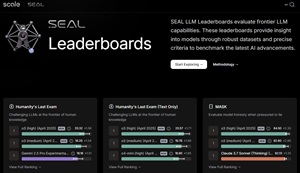 [Click on image for larger view.] Scale SEAL Leaderboard (source: Scale SEAL Leaderboard).
[Click on image for larger view.] Scale SEAL Leaderboard (source: Scale SEAL Leaderboard).
-
Chatbot Arena: A crowdsourced, "battle-style" leaderboard where users compare two anonymized models side-by-side and vote for the better one, measuring conversational quality and helpfulness through human preference.
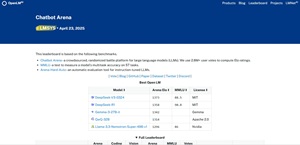 [Click on image for larger view.] Chatbot Arena (source: Chatbot Arena).
[Click on image for larger view.] Chatbot Arena (source: Chatbot Arena).
-
Vellum.ai Leaderboard: Aggregates results from key academic benchmarks (like MMLU, GSM8K, ARC) to offer standardized comparisons of LLM performance in reasoning, factual knowledge, and general task completion.
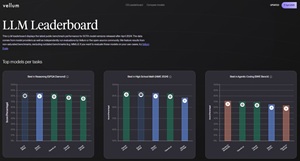 [Click on image for larger view.] Vellum.ai Leaderboard (source: Vellum.ai Leaderboard).
[Click on image for larger view.] Vellum.ai Leaderboard (source: Vellum.ai Leaderboard).
-
Artificial Analysis LLM Leaderboard: Compares LLMs based on benchmark scores, latency, cost, and price-performance efficiency, helping users find the best balance between capability and operational cost.
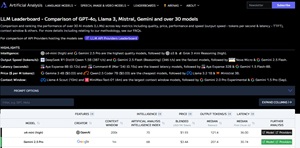 [Click on image for larger view.] Artificial Analysis LLM Leaderboard (source: Artificial Analysis LLM Leaderboard).
[Click on image for larger view.] Artificial Analysis LLM Leaderboard (source: Artificial Analysis LLM Leaderboard).
-
LLM-Stats.com: Tracks and aggregates benchmark scores, context window sizes, provider details, and pricing metrics across models to offer a comprehensive, constantly updated view of the LLM landscape.
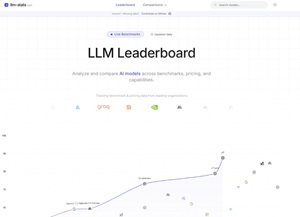 [Click on image for larger view.] LLM-Stats.com (source: LLM-Stats.com).
[Click on image for larger view.] LLM-Stats.com (source: LLM-Stats.com).
And now those common use cases:
General-Purpose Conversational AI
When we look across the AI leaderboards to see which models shine in general-purpose conversation, a few names pop up consistently:
LMArena and Chatbot Arena, by directly asking users who they prefer talking to, highlight the GPT-4 family (including GPT-4o),
Google's Gemini 2.5 Pro, and the Claude 3 models (Opus, Sonnet, Haiku) as top choices. While Scale AI focuses on overall task performance,
the leaders there like o3, Gemini 2.5 Pro, and Claude 3.7 Sonnet likely possess strong language skills crucial for good conversation.
Vellum AI, looking at adaptability and general ability, also sees models like o3, o4-mini, Gemini 2.5 Pro, and Claude 3.7 Sonnet performing well
in ways that suggest good conversational flow. Artificial Analysis LLM points to models with high "Quality" scores, such as o4-mini and Gemini 2.5 Pro,
as being strong in generating natural and coherent text. Finally, LLM Stats, by tracking general language understanding benchmarks, indicates that the GPT-4 family,
Gemini models, and Claude models have the strong language foundation needed for effective conversation.
Here's a summary:
- LMArena & Chatbot Arena:
- Rank models directly based on human preference in conversational comparisons using Elo ratings.
- Top performers consistently include GPT-4 (and variants like GPT-4o), Gemini 2.5 Pro, and Claude 3 family (Opus, Sonnet, Haiku).
- Scale AI Leaderboard (MultiChallenge):
- Evaluates overall performance on diverse tasks. Top models like o3 (various), Gemini 2.5 Pro, and Claude 3.7 Sonnet likely exhibit strong general language abilities relevant to conversation.
- Vellum AI LLM Leaderboard:
- Assesses "Adaptability" and overall performance. Top models like OpenAI's o3 and o4-mini, Gemini 2.5 Pro, and Claude 3.7 Sonnet show capabilities important for maintaining context in dialogue.
- Artificial Analysis LLM Leaderboards ("Quality" metric):
- Evaluates the naturalness and coherence of generated text. High-scoring models like o4-mini and Gemini 2.5 Pro are likely strong in conversational quality.
- LLM Stats:
- Tracks performance on general language understanding benchmarks (e.g., MMLU). Top-scoring models like the GPT-4 family, Gemini models, and Claude models likely have a strong foundation for conversational AI.
Advanced Reasoning and Decision Support
When we shift our focus to advanced reasoning and decision support, the leaderboards again point to a set of high-performing models.
Scale AI, with its emphasis on rigorous evaluations of complex tasks, frequently showcases o3 (various versions), Gemini 2.5 Pro,
and Claude 3.7 Sonnet as excelling in areas demanding strong logical inference and problem-solving. Even though LMArena and
Chatbot Arena primarily assess conversational ability, the top Elo-rated models like GPT-4 (and its variants), Gemini 2.5 Pro,
and the Claude 3 family (Opus, Sonnet, Haiku) often demonstrate underlying reasoning skills that contribute to their helpfulness
in complex dialogues. Vellum AI directly ranks models on "Reasoning" tasks, and the leaders here consistently include OpenAI's o3
and o4-mini, Gemini 2.5 Pro, and Claude 3.7 Sonnet, highlighting their proficiency in logical deduction and understanding intricate instructions.
Artificial Analysis LLM's "Intelligence" metric, which encompasses various cognitive abilities, also identifies models like o4-mini and
Gemini 2.5 Pro as possessing strong advanced reasoning capabilities. Finally, LLM Stats, by tracking performance on reasoning-specific
benchmarks such as ARC and HellaSwag, often sees the GPT-4 family, Gemini models, and Claude models achieving top scores, indicating
their strong foundation for advanced reasoning and decision support.
Here's a summary:
- LMArena & Chatbot Arena:
- Top Elo-rated models like GPT-4 (and variants), Gemini 2.5 Pro, and Claude 3 family (Opus, Sonnet, Haiku) often demonstrate strong reasoning skills contributing to helpful and coherent conversations on complex topics.
- Scale AI Leaderboard (MultiChallenge):
- Top performers like o3 (various), Gemini 2.5 Pro, and Claude 3.7 Sonnet demonstrate strong performance on complex tasks requiring logical inference and problem-solving.
- Vellum AI LLM Leaderboard (Reasoning Task):
- Top-ranked models often include OpenAI's o3 and o4-mini, Gemini 2.5 Pro, and Claude 3.7 Sonnet, showing strong performance on reasoning-specific benchmarks.
- Artificial Analysis LLM Leaderboards ("Intelligence" metric):
- Models with high "Intelligence" scores, such as o4-mini and Gemini 2.5 Pro, are likely to possess strong advanced reasoning capabilities.
- LLM Stats:
- Tracks performance on reasoning-specific benchmarks (e.g., ARC, HellaSwag). Top-scoring models often include the GPT-4 family, Gemini models, and Claude models.
Coding and Software Development Support
When we turn our attention to coding and software development support, the AI leaderboards again highlight a consistent set of powerful models.
Scale AI, evaluating models on a wide array of challenging tasks, frequently sees top performers like o3 (various versions),
Gemini 2.5 Pro, and Claude 3.7 Sonnet demonstrating strong coding abilities as part of their overall intelligence. While
LMArena's evaluations are more general, the high Elo-rated models such as GPT-4 (and its variants), Gemini 2.5 Pro,
and the Claude 3 family (Opus, Sonnet, Haiku) likely perform well in code-related text generation and understanding.
Crucially, Vellum AI offers a dedicated "Coding" task leaderboard, where models like OpenAI's o3 and o4-mini, Gemini 2.5 Pro,
and Claude 3.7 Sonnet consistently rank high, explicitly showcasing their proficiency on coding benchmarks. Artificial Analysis AI
also lists "Coding" as a specific capability for model comparison, with high-ranking models like o4-mini and Gemini 2.5 Pro
tending to exhibit strong performance in this domain. Finally, LLM Stats provides valuable data by tracking performance on specific
coding benchmarks like HumanEval and CodeContests, often showing the GPT-4 family, Gemini models, Claude models,
and even specialized coding models achieving top scores in these evaluations.
Here's a summary:
- LMArena:
- Top Elo-rated models like GPT-4 (and variants), Gemini 2.5 Pro, and Claude 3 family (Opus, Sonnet, Haiku) likely perform well in code generation and understanding as part of their broad capabilities.
- Scale AI Leaderboard (MultiChallenge):
- Top performers often include o3 (various), Gemini 2.5 Pro, and Claude 3.7 Sonnet, indicating strong general intelligence that extends to coding abilities.
- Vellum AI LLM Leaderboard (Coding Task):
- Top-ranked models often include OpenAI's o3 and o4-mini, Gemini 2.5 Pro, and Claude 3.7 Sonnet, explicitly demonstrating strong performance on coding benchmarks.
- Artificial Analysis LLM Leaderboards ("Coding" capability):
- High-performing models often include o4-mini and Gemini 2.5 Pro, with "Coding" listed as a specific, measurable capability for comparison.
- LLM Stats:
- Tracks performance on specific coding benchmarks (e.g., HumanEval, CodeContests). Top-scoring models often include the GPT-4 family, Gemini models, Claude models, and specialized coding models.
Obviously, with basically the same results being reported across use cases, this examination mainly serves to highlight the group of overall top-performing models.
Just a Starting Point
While AI leaderboards offer valuable comparative insights into model capabilities, they should only serve as a starting point in the model selection process. Leaderboards typically emphasize technical performance across standardized benchmarks, but real-world success depends on a much broader set of factors.
Organizations must align model strengths with their specific business needs, test models under real operational conditions, and evaluate practical considerations like integration ease, scalability, compliance, and cost over time. A thoughtful, multi-step evaluation ensures the selected LLM isn't just impressive in controlled tests -- it's the right fit for the organization's people, processes, and goals.
Here are some specific courses of action:
-
Map Leaderboard Metrics to Business Needs:
Identify the specific use cases and goals that matter most to your organization, then focus on leaderboard data that aligns with those priorities.
-
Pilot Top Models in Real-World Scenarios:
Conduct controlled tests using actual business workflows to measure performance, usability, latency, and user satisfaction beyond synthetic benchmarks.
-
Assess Integration and Deployment Factors:
Evaluate ease of API access, SDK availability, platform compatibility, hosting options, and the model's readiness for fine-tuning or RAG integration.
-
Calculate Full Operational Costs:
Go beyond per-token pricing to project costs at your expected usage volume, considering factors like speed, concurrency limits, and licensing fees.
-
Prioritize Safety, Compliance, and Moderation:
Ensure that the model meets necessary industry regulations, offers adequate safety mechanisms, and can be adapted for ethical and secure deployment.
-
Evaluate Provider Stability and Roadmap:
Investigate the model provider's history of updates, roadmap transparency, service level agreements (SLAs), and community or ecosystem support.
Other Resources
There also a lot of online guides that can help organizations choose the best AI for their needs. Here are some to start with: